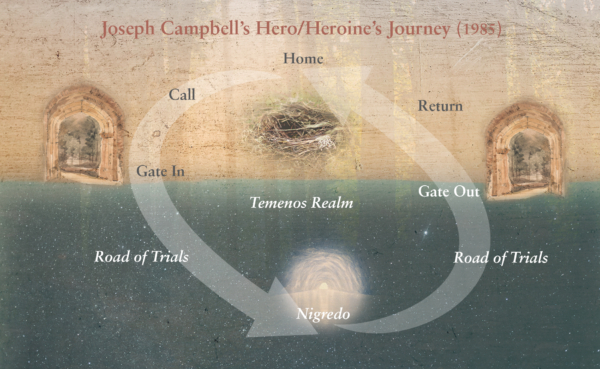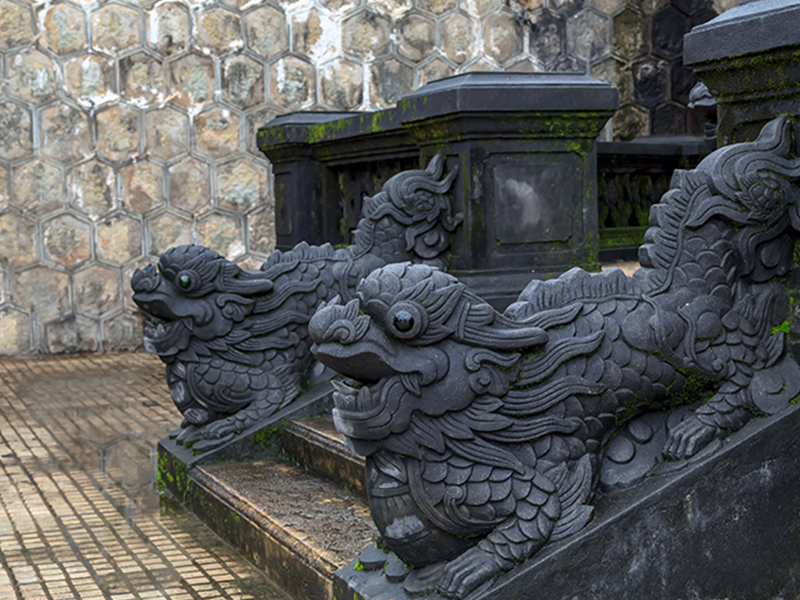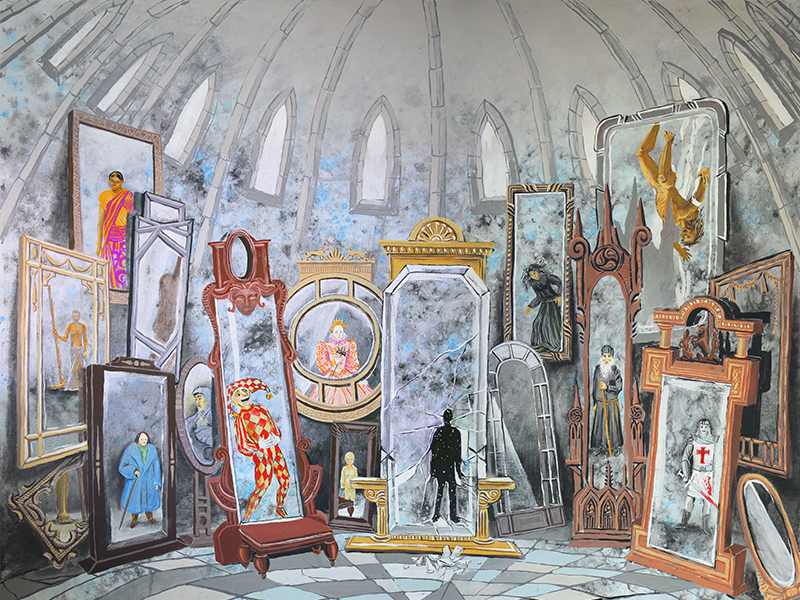In the Hero/Heroine’s Journey series we are at the first half of the Road of Trials. It’s a Ritual Journey, and traveled often with archetypal companions. Archetypes support life and stereotypes deaden; it’s important to know how to tell the difference.
The Hero/Heroine’s Journey is a ritual, a series of actions in a prescribed order. The focus of the ritual is transformation. Joseph Campbell labeled the actions and their order, extracting them from stories from all over the world. Carl Jung, from stories but also dreams, invented some of the language Campbell would use. This blog focuses on the Road of Trials BEFORE the Nigredo (the place/space/time of transformation at the heart of the journey, 180º from Home). Because we travel often with archetypal companions, we will explore the difference between archetypes and stereotypes. Archetypes support life, and stereotypes deaden. Both are in us, surround us, show up on the Journeys we make. Previous blogs exploring the Hero/Heroine’s Journey can be found in the Story as Transformer section of my website. When you sign up to join the conversation you receive a Hero/Heroine’s Journey booklet.
In our blog exploration we now are inside the Gate In, fully entered into the Temenos realm. Our feet (physical and metaphorical) travel the Road of Trials, taking us through multiple adventures, including the Nigredo, until reaching the opposite position of the Gate Out. We live both in the literal world in clock time, and in the altered space/time of the Temenos. Sometimes it is difficult to tell the difference. The feeling of displacement in time is one clue that we are on a journey.
How to Recognize the Road of Trials
The Trials are a series of adventures that:
- are opportunities for growth, and tests occur
- differ before and after the Nigredo:
- before prepare us for the transformation
- afterwards help integrate the learning, and practice being who we are now.
- include companions – friends and enemies – relevant to the current journey
- introduce archetypal characters and events
When a Call is heard and the Hero/Heroine leave Home they travel a warm-up journey to the Gate In. In faery stories they often know the reasons for leaving Home, and it is usually an archetype: they seek the Water of Life in one shape or another. In the stories they meet the Other, and the way the interaction goes determines if they reach the Gate In.
Other clues to being on a Road of Trials come from who is in your life and dreams. When in the Temenos realm the entities you meet can be helpful or neutral or disposed to be neither. Some are tricksters, presenting one face that later changes into something else. This is true in the world outside the Gates, in everyday reality. Not all family members are safe; not all smiling people with a deal are your friends.
How to tell friend from foe? How to tell an archetype from a three-dimensional being? How to journey?
Companions, Stereotypes, Archetypal Characters and Events
Companions on our journey in the exterior world we live in can include:
- animals, both real and totem
- favorite stories that offer us advice and comfort
- family and friends, especially those who are savvy about transformation and supportive of changes
- guides: therapists, mentors or other soul and practical helpers
- beings carrying archetypes and interacting with us as archetypes (explored below)
Human template characters easily recognized in both the old stories and in modern world situations include both positive and negative manifestations.
Dyads:
King/Queen – an authority, the old order of things
Mother/Father – role; can be positive or negative
Old Woman/Old Man – Mentors, holders of ancestral wisdom,
often gives advice, which may or may not be useful
Prince/Princess – often the Hero or Heroine of a story
Individuals:
Employee: Maid, Hunter, Soldier, Warrior, Servant – Worthy person given specific tasks, sometimes the Hero/Heroine
Shadowy character: Thief, Magician, Trickster – skilled at illusion, slight of hand, magic
Gate Keeper – found at thresholds, asks questions, has information for the seeker.
There are non-corporal archetypes:
– Spirits, ghosts
– Angels, devils
– Dream figures
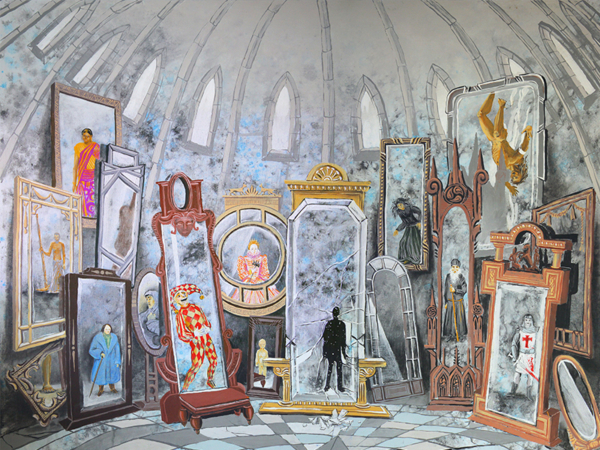
There are stereotypes of these characters and there are archetypes. I’ve been asked how to tell the difference, and the answer for me lies in the archetypes’ numinosity, their mysterious, otherworldly numen (divine will), a kind of shining. A stereotype is a widely recognized but oversimplified image that exists to flatten, dull, make less or more dangerous what is being described. It is what comedians mock.
The natural world has archetypes; many are used symbolically, and many can be stereotyped:
- Colors – we ask “if you were a color what color would you be?” on one hand, referring to the archetype sense of that color; we also use colors to create stereotypes of race.
- Numbers – we prefer/dislike certain numbers. The number 13 used to be lucky (a baker’s dozen was 13; age 13 marks an initiatory journey) but now often is seen as negative.
- Directions – Solar E, S, W, N and Lunar/Star Cross-Quarters are orientation energies, invoked in ritual ceremony; flattened stereotypes are like South vs North, or “Go West, Young Man”
- Plant realm: Tree, flower – found as symbols everywhere, often carrying an archetypal understanding “rooted like an oak”, “the rose at the center of the fire”.
- Natural world realm: ants, fox, fish, horse, bird (Firebird, Mother Goose), others appear as helpers in fairy stories. They have archetypal significance: ants sort seeds, fox are savvy, horse is guide and companion, bird in a cage…
Some natural world archetypes become major cultural icons like Raven, Turtle, Eagle, Coyote. Tribes, organizations, teams align themselves with animal archetypes, like the Bear Clan or the Lions Organization. My website’s major image is the archetypal transformer Raven.
For a master list of archetypes it is worth looking at the indexes of the first Dungeon Master books from the role-playing game Dungeons and Dragons. Quora will also provide useful information.
In this role-playing game your character joins other players’ characters in a setting determined by the Dungeon Master. The party travels together through a Road of Trials (though not called that usually). I love that characters earn experience points and skills that they take with them into other adventures.
Archetypes can be beings that take shape in your dreams, from your personal un/sub/conscious and whose formation is usually a message from yourself to yourself. When going through a transformation about diet and weight, a voracious eater something like an unintelligent Chewbacca arrived in my dreams and waking moments; I named her Galumpf. A series of Turtle dreams marked a major life transition and became a foundation for the short story Turtle Dreams.
One major clue to being on a Road of Trials is that beings (human and otherwise) in the literal world double as archetypes on the interior journey. It’s very important to not paste your Father archetype on your real father or your boss or the leader of your country, for examples. It’s also very important to realize beings show up carrying archetypes and interacting with us as archetypes because it is useful to our current transformation. You have to stay awake to do the dance.
The stories tell us when you recognize the presence of the Other, approach with your best manners, with a clean heart, and a clear motivation. When asked a question, answer it, telling the truth. These beings are not here to serve you. They may be there to test you, or stop you from getting ahead. They may choose to offer aid and information. Do not mistake them for your imagination.
Road of Trials Maps and Tasks
Roads of Trials occur as we travel through our lives. It’s useful to be able to recognize when you are traveling along one. The Hero/Heroine’s Journey is a map to the transformation process; we live one arc that begins with our birth and ends when we return to Home. Our ancestors left us the fables, myths, and stories as specific maps for specific journeys. Joseph Campbell suggests it is useful to know what story you are in, and where you are in the story. Reading stories is one way to find a map; ask yourself which stories resonate with you right now, what are you reading or watching that is sustaining you.
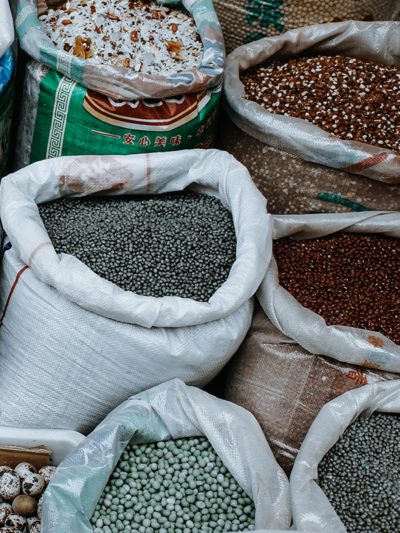
There are also specific tasks commonly found on the before the Nigredo section of the Road of Trials. Here are four examples:
-
- “Sorting-seeds” is learning Discernment; you are deciding what is alive and what is dead, what will be let go in the Nigredo and what will come out with you on the other side.
- “Water of Life” is Focus; answering the questions “what is it that I want, what needs to be done?”
- “Black Wool from the Rams” is Manage Power; the phrase is taken from Vasalisa the Beautiful (see the play I wrote, Waiting for Baba Yaga ) but many stories demonstrate how to deal with beings more powerful than you.
- “Waiting” is Gain Perspective. Vasalisa waits for Baba Yaga, the woman waits atop the glass mountain, the soldier waits until the trapdoor opens to the underworld…
Note that these tasks are developmental; they encourage the Hero/Heroine to be wiser, stronger, and more aware. They also prepare the Journey Maker for the Nigredo, the time/place of transformation, mid-way on the Road of Trials.
Where are you on your current Road of Trials, Journey Maker?
Looking back, what transformation journeys have you completed?
What gifts of skills and knowledge did the Road of Trials give you?

